The short circuit MIG transfer method is a widely used technique in the field of welding, known for its versatility and efficiency.
Short-circuit MIG welding offers precise control over heat input, resulting in reduced spatter, increased weld quality, and improved productivity.
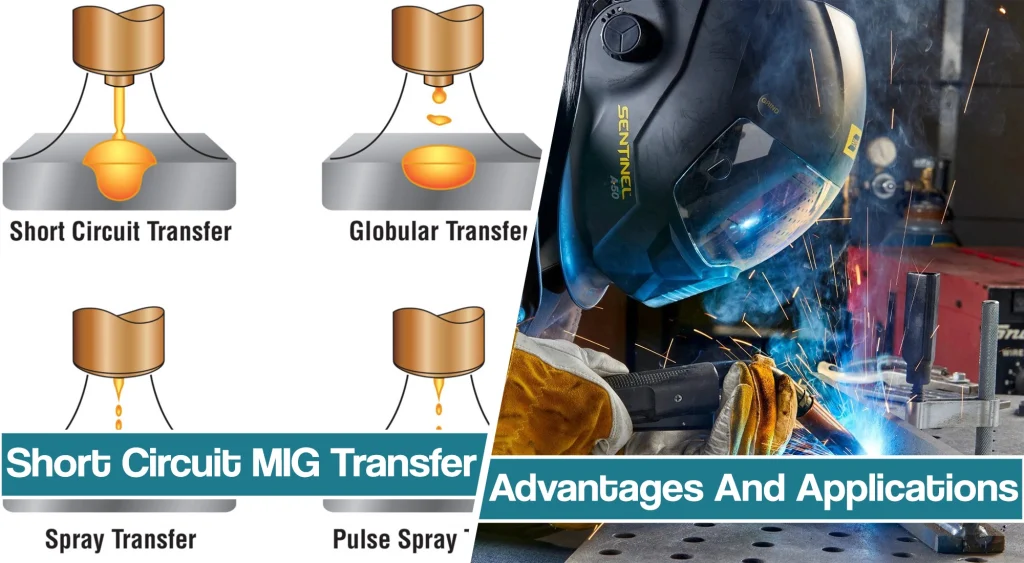
Through a combination of electrical currents and controlled wire feeding, this method enables the fusion of metals with exceptional precision, making it a preferred choice for various industries. This article delves into the intricacies of this innovative process, exploring its fundamental principles, advantages, and applications.
What Is A Short Circuit Transfer?
Short-circuit metal transfer mode, also known as short-circuit MIG welding (Gas Metal Arc Welding), is a process that involves the transfer of metal droplets across the welding arc in a controlled manner. In the short-circuit MIG welding techniques, the wire electrode comes into contact with the workpiece, causing a short circuit to occur. This results in a momentary drop in voltage, which in turn reduces the heat input.
As a result, the welding wire quickly retracts, breaking the short circuit and allowing the process to repeat. This cyclical motion creates a series of small, controlled droplets that are transferred to the weld pool. One of the key advantages of the short-circuit mode is its ability to minimize heat input, which is especially beneficial when welding thin materials.
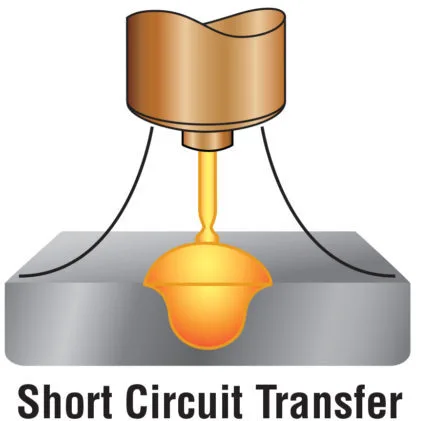
By controlling the electrical parameters and filler wire feed rate, welders can achieve precise control over the size and frequency of the droplets, resulting in improved weld quality and reduced spatter.
What Are The Settings for Short Circuit MIG Transfer?
The settings for MIG short-circuit welding can vary depending on factors such as the material being welded, the wire diameter, the joint configuration, and the welding machine being used. The voltage setting determines the heat input and penetration of the weld. For short-circuit MIG welding, the voltage is typically set in the range of 15 to 18 volts, with power between 100 and 180 amps.
The appropriate wire feed speed depends on the solid wire diameter, material thickness, and welding position. As a starting point, a wire feed speed of around 150 to 300 IPM is often used for short-circuit MIG welding. Some MIG welding machines allow for adjusting the inductance settings. Inductance affects the electric arc characteristics and can be used to fine-tune the arc stability and reduce spatter.
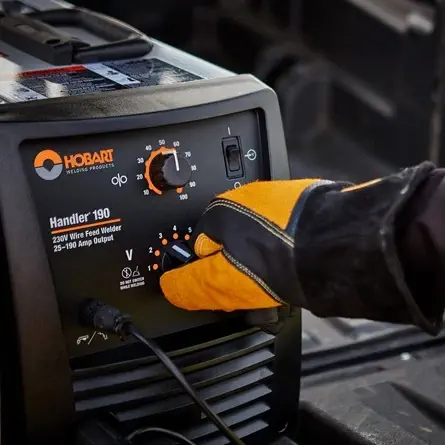
For short-circuit transfer, a common shielding gas is a mix of argon and carbon dioxide (CO2), often referred to as C25 gas (25% CO2 and 75% argon). The shielding gas promotes this transfer and protects the molten weld puddle from contamination.
What is short circuit transfer normally used for?
Short-circuit transfer in MIG welding is commonly used for welding thin to medium-thickness materials. It offers several advantages in specific welding applications:
Thin Materials: Short-circuit transfer is particularly suitable for welding thin materials, typically ranging from 24 gauge (0.025 inch or 0.6 mm) up to around 1/8 inch (3.2 mm) thickness. The lower heat input associated with short-circuiting minimizes the risk of distortion, burn-through, and warping, making it ideal for delicate and thin metals.
Sheet Metal Fabrication: Short-circuit transfer is widely employed in sheet metal fabrication, where precision, control, and aesthetics are crucial. It allows for accurate and clean welds on thin sheets of metal, such as in automotive bodywork, HVAC systems, and appliance manufacturing.
Joining Dissimilar Metals: Short-circuit MIG welding is effective for joining dissimilar metals, such as stainless steel to carbon steel or aluminum to steel. Its controlled heat input reduces the likelihood of metallurgical issues, such as cracking or excessive dilution, that can occur when joining different metals.
Out-of-position Welding: Short-circuit transfer can be used for welding in various positions, including vertical and overhead. The reduced heat input and improved control minimize the risk of weld defects, making it more manageable to achieve sound welds in challenging positions.
Repair and Maintenance: Short-circuit transfer is also valuable for repair and maintenance tasks, allowing for precise and controlled welding of damaged or worn components. Its versatility and ability to weld a wide range of materials make it useful in various repair applications across industries.
Advantages Of Short Circuit Transfer
Short-circuiting transfer in MIG welding offers several advantages that make it a popular choice in various applications:
Reduced Heat Input: Short-circuit transfer has a lower heat input compared to other welding methods, such as globular and spray transfer modes. This is beneficial for welding thin materials as it minimizes the risk of distortion, burn-through, and warping. The controlled heat input also helps preserve the mechanical properties of the base metal, reducing the chances of material degradation.

Minimal Spatter: Short-circuit transfer typically produces less spatter compared to other transfer modes. Spatter refers to the small molten metal droplets that can scatter and adhere to nearby surfaces during welding. The reduced spatter not only improves the aesthetics of the weld but also reduces the need for post-weld cleaning, saving time and effort.
Precise Control: The short-circuit mode allows for precise control over the welding process. Welders can adjust the parameters, such as voltage and wire feed speed, to regulate the size and frequency of the metal droplets being transferred. This control results in consistent and uniform welds with minimal variations, enhancing the overall quality of the weld joint.
Versatility: Short-circuit transfer is applicable to a wide range of materials, including carbon steel, stainless steel, and aluminum. This versatility makes it a preferred choice in industries such as automotive, construction, and manufacturing, where different materials need to be joined. By using appropriate filler metal and shielding gases, short-circuit transfer can achieve reliable and strong welds in various metal combinations.
Ease of Use: Short-circuit transfer is relatively easy to learn and operate, making it suitable for welders of different skill levels. The controlled nature of the process, along with reduced spatter, makes it more forgiving and user-friendly. This simplicity and ease of use contribute to increased productivity and efficiency in welding operations.
Cost-Effective: Short-circuit transfer is a cost-effective welding method. The lower heat input reduces energy consumption, and the minimized spatter reduces material waste. Additionally, the ease of use and versatility of short-circuit transfer make it a time-efficient process, leading to improved productivity and reduced labor costs.
Short Circuit Vs Globular Transfer
The main difference between the two transfer modes lies in the size and frequency of the droplets transferred. In short-circuit transfer, the droplets are small and occur at a rapid rate due to the cyclic nature of the process. This results in lower heat input and reduced spatter. In globular transfer, the droplets are larger and transfer less frequently, leading to higher heat input and increased spatter.
Short-circuit transfer is commonly used for welding thin materials and in applications where precise control and minimal spatter are desired, such as sheet metal fabrication. It offers improved weld quality, reduced distortion, and increased productivity.
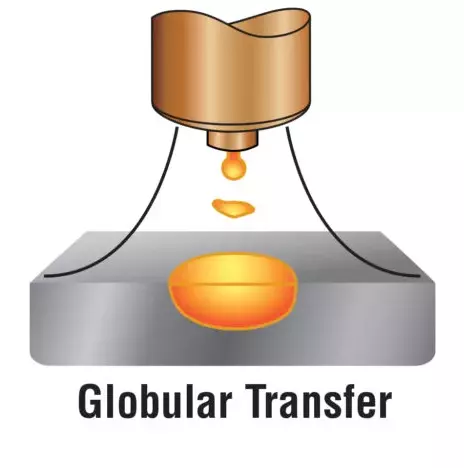
On the other hand, globular transfer is typically employed when welding thicker materials or when higher deposition rates are required. It can be more challenging to control and may result in more spatter. However, globular transfer can be useful in certain applications, such as when welding in vertical or overhead positions.
Short Circuit Vs Spray Transfer
The primary difference between the two transfer modes lies in the size and velocity of the droplets transferred.
In short-circuit transfer, the droplets are small and transfer at a relatively low velocity due to the controlled nature of the process. This results in reduced heat input and minimal spatter.
In spray transfer, the droplets are smaller and travel at a higher velocity due to the increased energy. The high velocity allows for a longer arc length, enabling the droplets to reach the weld pool without making contact with the workpiece.
Spray transfer mode typically produces a higher deposition rate and deeper penetration compared to short-circuit transfer.
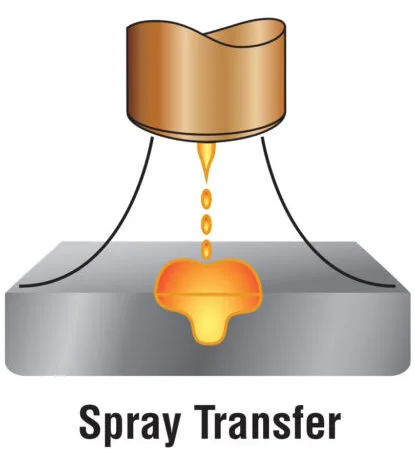
Short Circuit Vs Pulsed Spray Transfer
The main difference between short-circuit transfer and pulsed spray transfer lies in the manner in which the droplets are transferred.
In short-circuit transfer, the droplets are small and transfer in a controlled manner due to the cyclic nature of the process. This results in reduced heat input, minimal spatter, and precise control over the welding process.
In pulsed spray transfer, the droplets are smaller than in conventional spray transfer but larger than in short-circuit transfer.
They are transferred at a higher velocity during the high current phase, similar to spray transfer. However, the low current phase allows for a momentary pause, reducing the heat input and providing greater control over the weld pool.
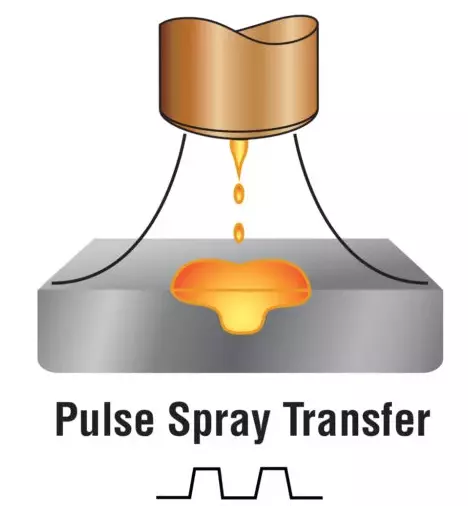
Drawbacks Of Short Circuit Transfer
While short-circuit transfer in MIG welding offers several advantages, there are also some potential drawbacks to consider:
- Limited Deposition Rate: Short-circuit transfer typically has a lower deposition rate compared to other transfer modes, such as spray transfer or pulsed spray transfer. This means that it may take longer to complete a weld or achieve a desired weld size, which can impact productivity in certain applications where high deposition rates are required.
- Restricted Joint Penetration: Due to the lower heat input of short-circuit transfer, it may have limited joint penetration, especially when welding thicker materials. This can result in reduced weld strength and may require additional weld passes or techniques to ensure sufficient penetration and fusion.
- Increased Susceptibility to Cold Lap: Cold lap, also known as lack of fusion, can be more pronounced in short-circuit transfer, particularly when welding thicker materials. The lower heat input and rapid solidification of the weld pool can make it challenging to achieve complete fusion between the base metal and the weld metal, leading to weak or defective welds.
- Limited Suitability for All Positions: While short-circuit transfer can be used in various positions, including vertical and overhead, it may be less suitable for welding in certain positions compared to other transfer modes. Welding out-of-position with short-circuit transfer requires precise control and technique to ensure proper fusion and avoid weld defects.
- Sensitivity to Fit-Up Gap: Short-circuit transfer can be more sensitive to fit-up gaps and variations compared to other transfer modes. Tight fit-up and proper joint preparation are crucial to maintain a stable short-circuiting arc and achieve consistent and quality welds. Larger gaps or inconsistent fit-up may result in increased spatter, lack of fusion, or weld defects.
- Not Ideal for Aluminum Welding: Short-circuit transfer is typically not the preferred mode for welding aluminum. Aluminum tends to require higher heat input and greater energy to achieve successful welds. While short-circuit transfer can be used for thinner aluminum materials, spray transfer or pulsed spray transfer are generally more suitable for achieving better penetration and fusion in aluminum welding.
Conclusion
Short-circuit transfer in MIG welding or flux-cored arc welding is a versatile and valuable technique, particularly for welding thin to medium-thickness materials. It offers numerous advantages, including reduced heat input, minimal spatter, precise control, versatility, ease of use, and cost-effectiveness. The controlled nature of the process allows for clean and precise welds, making it ideal for applications such as sheet metal fabrication, joining dissimilar metals, out-of-position welding, and repair and maintenance tasks.
By understanding its strengths and weaknesses, welders can effectively harness the benefits of short-circuit transfer while mitigating its limitations. Proper parameter settings, joint preparation, and technique can help optimize the process and achieve high-quality welds.
Resources
- https://www.hobartbrothers.com/resources/technical-articles/welding-transfer-modes-tips-for-achieving-the-best-results/
- https://www.thefabricator.com/thewelder/article/consumables/understanding-transfer-modes-for-gmaw
- https://weldingtech.net/short-circuiting-transfer/
- https://weldreality.com/short_circuit_under100.htm
- https://www.twi-global.com/technical-knowledge/job-knowledge/mig-mag-developments-in-low-heat-input-transfer-modes-133
- https://www.jasic.co.uk/post/mig-welding-modes-of-transfer





